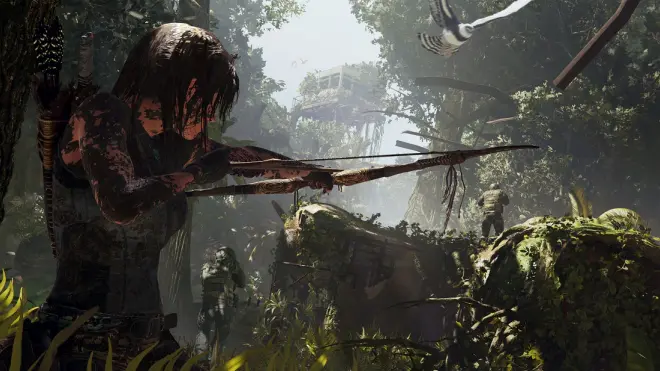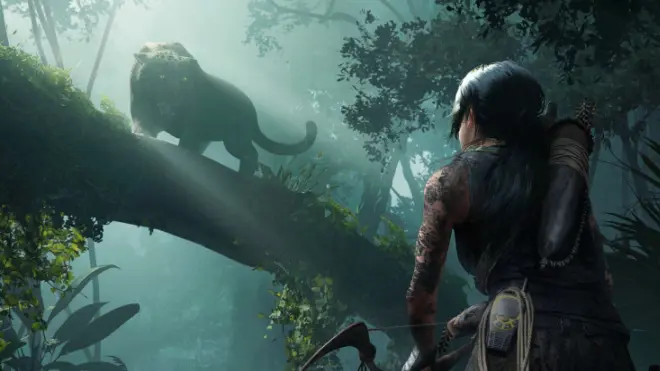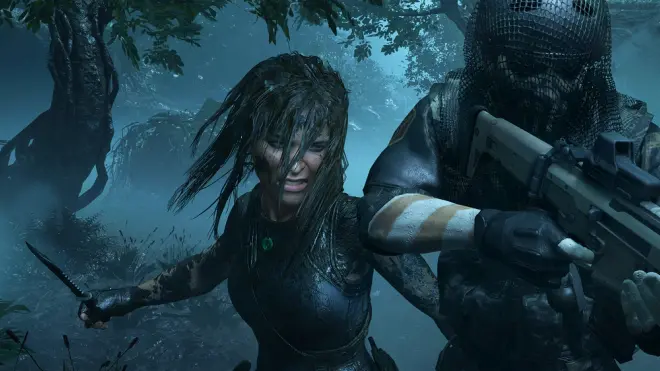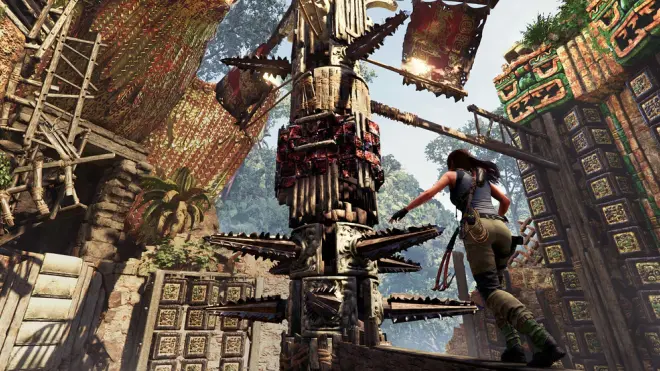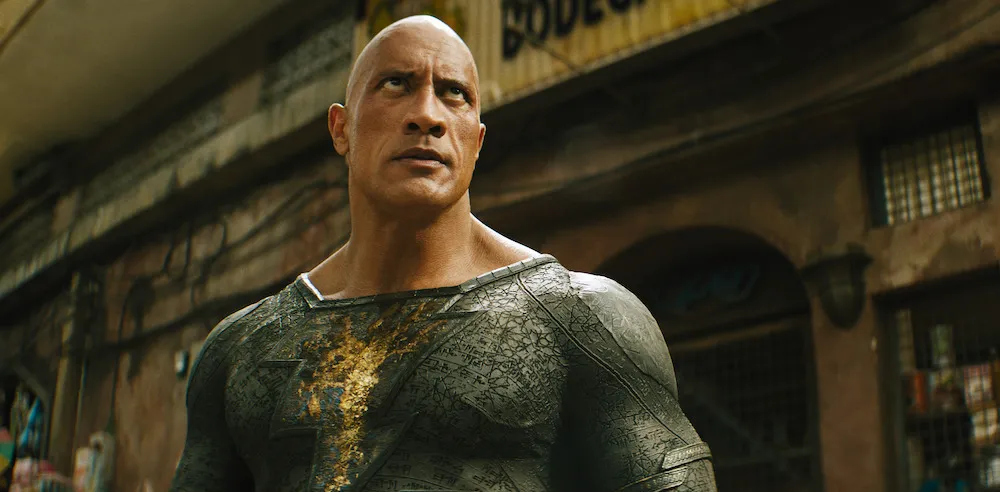Shadow of the Tomb Raider, as the last game in the reboot trilogy, is an absolutely memorable and highly exciting experience. Finely honed gameplay juxtaposed against inspired art and sound design guarantees that players will be transported into the heart of the Peruvian jungle — and have a hell of a time doing it.
The story opens with our titular tomb raider, a steely Lara Croft, staring down an imminent plane crash over the Peruvian jungle. At her side, a frenzied yet stalwart companion in the form of Jonah, a tattooed hulk of a man with a heart of gold. Hail punishes the canopy of the aircraft, piercing the windshield and taking the pilot out. The plane lists drastically, the fuselage is torn asunder, and Jonah is swept away into the great unknown as Lara stares down yet another promise of death.
And that’s just the few minutes spanning the introductory prologue.
Shadow of the Tomb Raider, out now on the Xbox One, Playstation 4, and PC, is the third and final installment of the re-imagined trilogy that rebuilt the franchise from the ground up, essentially disregarding previous canon and plunging forward into a new story with a fresh-faced heroine at the helm.
Lara Croft is once again given voice by veteran actress Camilla Luddington, who spares no nuance in her portrayal of the marquee character. At times soft and caring, at others fierce and full of violent resolve, Luddington lends an absolute air of believability to Croft that aids greatly in creating a sense of immersion that the reboot trilogy has built a reputation around.
The first few hours of gameplay of Shadow of the Tomb Raider serve as both a creative and technical introduction to the series, entertaining newcomers and seasoned players alike with a bevy of plot twists and novel skills and abilities to explore.
The player is given control of Croft just two days before the ill-fated flight, typically confronted with a claustrophobic tunnel to navigate before emerging into a mysterious chamber. After solving a basic puzzle – and being exposed to further expository cinematics – the player sees themselves commiserating over a few drinks with series sidekick Jonah Maiava in Cozumel, Mexico. Surrounding them are revelers, celebrating in somewhat modest fashion, commemorating the annual Dia de Muertos – or Day of the Dead – festival.
It is here that the visual appeal of the game first becomes apparent, although the graphics will become a central fixture of the game throughout. The portrayal of Cozumel is beautifully captured, neon lights and sugar skulls juxtaposed against the strains of stringed instruments and Spanish song. Every inch of the environment is decorated with a fine attention to detail, whether the focus be floral arrangements on a open-air bar table or a constellation of flickering lights wrapped about a merchants stall, closed for the evening’s festivities.
I was extremely impressed by the fullness of the game world, even at such an early point in the game’s narrative. It became immediately obvious to me that the art direction of Shadow of the Tomb Raider would take the excellent standard set by previous iterations in the trilogy and expound even further upon that bedrock, expanding both the scope and the depth of the visual experience to such a point that I truly felt like a cohesive and complete gaming environment had been realized.
The sound design – both the effects and the music that accompanies most of the dramatic scenes – contribute greatly to an unnerving sense of uncertainty and simple displacement, of other-worldliness.
Most tracks pay homage to the exotic nature of the setting, traditional woodwinds and strings painting haunting portraits in the mind’s eye in order to create a sense of spooky suspense. During times of greater intensity, say, during crucial battles or escape sequences, heavy drums in irregular syncopation get the blood pumping properly. The result is a rich tapestry of aural ambiance that is of equal quality to the professional-grade art and graphic design put forth by the team charged with closing out the Croft saga. Or, at least this particular portion of it.
Lara Croft, having figured out that her eternal antagonists — the collective known as the Order of Trinity – are behind certain actions taking place in Mexico and beyond, begins to infiltrate the crowd in search of a Dr. Dominguez. Early reports suggest that he is well-placed within the Trinity hierarchy. Assuming that he is the shadowy face behind the secret society that has been dogging her throughout her past adventures, Lara Croft sets out in search of the truth behind the artifact she had claimed earlier in the prologue.
From there the game slowly widens in scope, gradually introducing new pieces of equipment and innovative techniques that will serve the purpose of exploring the foliage-filled expanse that is the Peruvian jungle.
Weapons on hand include a makeshift knife – crafted from parts of a wrecked airplane – the traditional Croft recurve bow, and a bevy of pistols and assault rifles. Each weapon is fully upgradeable in a variety of ways, from bowstrings to butt stocks. I relished engaging in combat whether my opponent was a fierce, bloody-faced jaguar stalking me through the thick fronds and vines of the jungle or a Trinity-loyal mercenary ambling about outside of his deployment zone. Additional weapons, and parts for them, can be scavenged in containers scattered about the jungle as well as awarded for completion of the game’s many side quests.
A panoply of take-down techniques are presented to players – those that prefer stealth can attack from tree branches or from mud-covered hiding spots, while those that enjoy full-frontal action can avail themselves of the option. I personally prefer the latter in most games — Eidos’ Deus Ex franchise coming immediately to mind – but was just so stoked to see how intuitive the stealth integration into the flow of gameplay was that I found myself choosing the quieter, smoother method most times instead.
Combat is precise and particularly lethal – an unarmored Lara Croft will not stand up long while exposed to withering gunfire from trained killers or the claws of a vicious jungle predator. Awareness of hiding spots, potential cover, and sight-lines remains necessary for survival against the elements – natural or otherwise.
The tombs themselves – part and parcel to the experience of the Tomb Raider series as is apparent by the very title of the franchise – are presented to the player replete with difficult puzzles and deadly traps abound. The so-called Challenge Tombs will give even experienced series experts pause, particularly if you’re the sort of gamer that hates turning the difficulty down to anything lower than the hardest level and refuses to consult guides.
Most will find the Ancient Aqueduct Challenge Tomb to be the most frustratingly difficult, despite the improved swimming controls particular to Shadow of the Tomb Raider, but will be rewarded with an immediately rush of satisfaction and accomplishment upon its completion. The Tree of Life Challenge Tomb blends action and puzzles almost perfectly to my individual taste profile, and so I enjoyed it the most of those that I did sample.
The new release also boasts an expanded skill tree for those who truly enjoy RPG elements being injected into their action and adventure titles. The skill tree is divided into three general sections that best exemplify the modes of play taking place in the game universe – seeker skills, scavenger skills, and warrior skills. Seeker skills primarily concern environmental awareness, hunting abilities, and awareness of traps and hazards. Scavenger skills hinge around the gathering of uncommon and rare crafting materials, trap-making, and miscellaneous survival abilities. Warrior skills, simply put, focus on improving Croft’s combat potential, making her a murderous foe when equipped with a bow, more resistant to damage and sure-footed in tight situations.
I preferred a balanced approach to spending my earned experience, picking my favorite skills from each available section at will, though others will surely find their own preferred path.
Perhaps one of the dark horse draws of the Tomb Raider trilogy helmed by Eidos Montreal with an assist by Crystal Dynamics, and published by Square Enix, is the extremely inventive – and extremely graphic – death sequences. Should Lara Croft make an ill-timed jump or an unfortunate misstep into dangerous territory, the player is likely to be treated to a deliciously brutal death scene that prefaces an instant restart. Being impaled by spears, eaten alive by ravenous piranhas, or gunned down by bloodthirsty cultists has never looked so good. The imaginative and ignoble endings that can catch Croft unawares are almost innumerable, and are oh-so-fun to watch despite the frustration of getting yet another surprise game over.
Thankfully, the auto-save feature for Shadow of the Tomb Raider is generous – perhaps to a fault – as death is of little consequence and does not set gameplay back by any appreciable amount.
While there is a great deal of content in the game, chock-full of side quests and additional challenges for even the most hardened action-adventure aficionado, players should expect to complete the title in under fifty hours during a standard player through. Completionists – those that absolutely need a full list of unlocked achievements adorning their gaming profiles – can expect 20 to 30 hours more to squeeze every last drop of goodness out of the title.
Are we ready to face the facts?
The game that closes out the new Tomb Raider franchise may in fact be the best of the informal trilogy.
While that is a bold claim – to be sure – it does not come without evidence to support it. Shadow of the Tomb Raider is an extremely well crafted AAA experience that is essentially a swansong – or a love letter – to those that have stuck with our intrepid heroine in her new adventures.
Even, and perhaps especially, if said adventure takes the tomb raider throughout deadly dungeons, ice encrusted caverns, and lush jungles in search of forgotten treasures hidden deep within forbidden tombs.
Shadow of the Tomb Raider is available for Xbox One, Playstation 4, and PC on September 14th. This review is based on a Xbox One version of the game, with a review code provided by the publisher.
